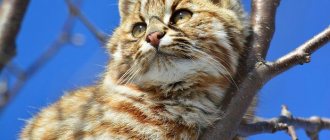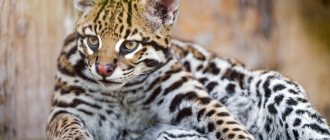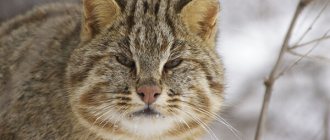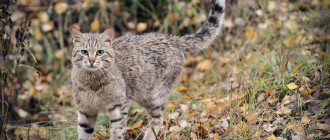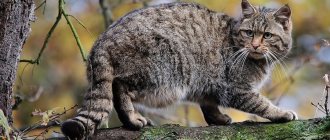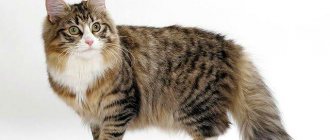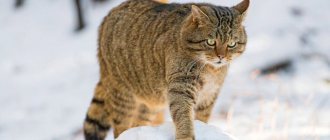Incredibly menacing and fluffy, cunning, cautious and sedate - all this is about the Amur Far Eastern forest cat, which lives near the Sea of Japan and in the Amur River basin.
This cat can also be found throughout the forested areas of China, Korea and the Hindustan Peninsula. INTERESTING: the closest relatives of the Amur forest cat are the Amur tiger and the Far Eastern leopard.
The first mention and description of the species dates back to 1871 and is associated not with the interest of naturalists, but with the fur trade. The same factor played a cruel joke on the population - beautiful fur led the population to critical status. Now the Far Eastern forest cat is listed in the Red Book, and its population size is estimated at only 2,500 individuals.
Appearance
The forest Amur cat belongs to the subspecies of the Belgian cat. Compared to other felines, the Far Eastern cat is small in size, slightly larger than a domestic mongrel cat. Males are larger than females, their average weight is about 8 kg, but in nature there are specimens reaching 15 kg.
Forest Amur cat
External description:
- the body is strong and muscular, 90 cm long;
- the claws are small but strong, easily retracted into the pads;
- the head, in comparison with the body, is small, the eyes are large, located close to each other, the forehead is high;
- wide-set ears, small in size;
- brown nose is wide and flat;
- the fangs are thick and sharp, thanks to which the animal can easily tear through tough and old meat;
- the fur is thick and long, the pile can reach 5 cm. This fur coat allows the cat to spend the winter in harsh conditions.
The cat's color is interesting. There are dark chocolate stripes along the back, and transverse red stripes on the neck. Also striped muzzle and paws. The entire reddish-red body is strewn with large rust-colored spots. This coloring gave the animal several more names - money cat and leopard cat.
Despite the dangers that the animal faces every day, leopard cats are considered long-lived. The secret of longevity lies in a calm lifestyle and a phlegmatic disposition. The cat leads a measured, unhurried life.
Money cat is another name for this breed
In winter, his heart rate and metabolism slow down. During the cold months, the animal’s life seems to freeze, which has a positive effect on life expectancy. On average, these animals live about 17 years.
What does it look like?
The Amur cat looks like the familiar domestic cat, although it belongs to a different subspecies. The length of its body is about 90 cm, almost half of which is the tail. Female animals are smaller than males, their body weight does not exceed 4 kg. Males, in turn, weigh approximately 8 kg. The inhabitant of the Far East boasts a muscular and flexible body, long limbs, a small head on which rounded ears are located. There are also such notable features:
- The eyes are close and deep-set.
- There is a stripe running down the middle of the nose, which is practically not covered by fur.
- The claws are short, and the fangs, on the contrary, are long.
Animal color
The color of the fur of the cubs of such an animal is close to leopard.
The Amur cat has a thick undercoat and soft fur. The color is gray-sand or yellow-brown. The body is decorated with red spots, which form 3 stripes on the back. They are also located on the limbs and throat. Kittens are more reminiscent of a leopard; in older individuals, the coloring becomes more even. The fur on the belly is lighter than on the back. There are also stripes on the head that start from the inner corners of the eyes. Thanks to this color, wild cats can hide unnoticed both on the ground and in trees.
Population status and conservation
Forest cat (European wild cat): habitat
Previously, the Amur cat lived throughout the Far East, but due to human negligence, the population has decreased significantly. Animals began to disappear as a result of plowing up virgin soil, cutting down trees, and fires in forests. Many specimens died in traps set by farmers. Since the animal was previously considered an enemy of agricultural crops, the subspecies was mercilessly exterminated.
Due to a sharp decline in the population, the Amur cat was listed in the Red Book. A high fine is imposed for killing an animal. According to rough estimates, about 3 thousand individuals live on the territory of Russia. Now the animal is found mainly in nature reserves and zoos.
Habitat
The Amur cat settled along the shores of the Sea of Japan and near the Amur basin. In addition to Russia, the Far Eastern cat is common in China, Japan and the Korean Peninsula, inhabiting the entire space from Hindustan to the Malay Archipelago.
Amur cat in Primorsky Krai
Since the area inhabited by the Amur cat is large and climatically heterogeneous, the habits of wild cats from different regions may differ from each other. In particular, the habitat affects the breeding periods and the mass of cats.
Amur cats are happy to explore the steppe
The tropical orientation of the Far Eastern cat suggests that impenetrable forests are not the best place for animals like him. However, circumstances were such that the Amur cat emigrated to the snowy Ussuri region and remained to live there forever.
Features of character and lifestyle
Leopard cat - the best breeds of this color
Far Eastern cats lead a solitary and nocturnal lifestyle. These animals jealously guard their home and do not allow strangers into their territory. They quickly become attached to their home and leave it only when there is no food. As a den, animals choose difficult-to-pass places - rock crevices, windbreaks. Such places will be good protection from large predators. Amur cats, and especially newborn kittens, have enemies such as wolves, sables, martens, eagle owls and golden eagles.
Important! Despite their long, thick fur, cats prefer to live on snowless rocks. This is explained by the fact that they cannot hunt in snow thicker than 30-40 cm.
The breed's intelligence makes it a formidable opponent - a small cat, protecting its offspring, can cope with a dog and even a wolf.
Interesting facts about the Amur forest cat
A few facts about the Amur forest cat:
- the Amur forest cat was identified as a separate subspecies only in the 1970s, when Russian zoologists compiled a description of the differences in the structure of the skull compared to other Bengal cats;
- this subspecies of the cat family has several more names - Far Eastern, leopard cat, which are associated either with its color or with its habitat;
- sometimes the Amur cat is called the reed cat, but these are two different species of the cat family;
- the Amur forest cat is depicted on the Bank of Russia 1 ruble silver coin issued in 2004;
- zoologists have discovered that males born as a result of hybridization are infertile, and cats are able to give birth;
- it is impossible to buy an Amur cat kitten, it is prohibited by law, sellers are criminals, and buyers are accomplices in the crime;
- In China, leopard cats are still hunted for their fur; after the European Union banned the import of the skins, Japan became the main buyer.
Far Eastern leopard cats are rare and beautiful cats. Now they are endangered, and it depends only on humans whether the population will be able to survive and increase the number of individuals.
Share with friends!
Reproduction, nutrition, age characteristics
Elk - a forest giant: 7 features from the life of an elk
From the end of February to the last days of March, the mating period begins. Males invite females to mating games with a loud roar. The roar is the only sound the animal makes. In other cases, the cat hisses. He does this rarely, only during times of approaching danger. The hissing is very quiet, almost inaudible to human hearing.
Pregnancy lasts 10 weeks. On average, no more than 4 kittens appear from one litter. The cubs are born small and blind and feed on mother's milk for up to 2.5 months.
Wild kittens
Babies' eyes open at 10 days of age, at 2 months they explore the world around them, and are ready for independent life only at 6 months. Sexual maturity occurs at 1-1.5 years.
Wild cats of the Far East are good and caring parents. When the cat is foraging for food, the mother cat jealously guards her offspring from large predators. When danger arises, the Amur forest cat carries and hides the babies in a new place.
Interesting! Cats very rarely abandon their offspring; this can only happen to young females. But if this happens, the babies can be taken by a domestic cat and raised as their own.
Due to their similar size, Amur cats often mate with stray cats. The kittens that are born turn out to be wild, and they are not able to live at home. This crossing allows you to increase the population of Far Eastern cats.
The diet of the wild Amur cat depends on the time of year. In spring, summer and autumn, the animal eats a lot to accumulate subcutaneous fat. One individual can eat about 20 mice and 3-4 small birds per day. Such abundant nutrition allows the cat to eat nothing for several days in winter.
Far Eastern cats are real hunters. They stalk their prey from hiding and are excellent tree climbers. When hunting, they instantly grab their prey and bite it with their long fangs. The diet includes hares, snakes, birds, and rodents. Also, they will not refuse the remains of the prey of large predators.
Important! If it is not possible to get the usual food, Amur cats can feast on fish, insects and reptiles.
Lifestyle of Far Eastern forest cats
These animals can live alone or in pairs, but during the breeding season several individuals gather together. Each cat has its own individual area of 5-9 square km. These predators lead a nocturnal and twilight lifestyle. Amur forest cats are shy and mistrustful, making them difficult to detect. They attack prey from an ambush, which they set up on the ground or in trees.
The Far Eastern forest cat reaches its prey in one leap.
In winter, Amur cats migrate from the mountains to valleys and hilltops, from which snow is blown away by the wind. During severe frosts, they can approach people's homes, where they catch rodents in old buildings.
If a Far Eastern cat is in danger, it takes refuge in a tree. They make shelters in hollows, rock crevices or among dense bushes; they also happily use abandoned holes of badgers and foxes. The bottom of the den is insulated with wood dust, leaves and grass.
Amur forest cats can excellently climb trees and rocks and swim well. The predator has several temporary shelters on the site. In winter, the safest permanent housing is used.
Far Eastern forest cats feed on mouse-like rodents, chipmunks, squirrels, Manchurian hares, birds and their eggs. Sometimes they can attack larger prey, for example, young deer and roe deer.
The lifespan of Amur forest cats in nature is 8-10 years, and in captivity they can live up to 15 years.
The diet of the Amur forest cat may include frogs and insects.
Is it possible to buy an Amur cat?
It is possible to purchase a Far Eastern cat, but it will be extremely difficult to do so. Since the sale of kittens is prohibited by law, sellers are criminals, and buyers are accomplices. The price for an Amur kitten is high.
After purchasing an animal, it needs to create favorable conditions:
- Make a spacious enclosure, so housing in an apartment will not be suitable.
- Limit the animal from communicating with adults. Do not allow contact with children.
- Feed live rodents and chilled poultry.
If you do not follow these simple rules, the life of your pet or family members can end in tears. When purchasing this breed as a pet, it is important to remember that this is a wild and aggressive animal that will be unhappy in captivity and will never allow humans near it.
The animal cannot be trained
Captivity
Like other wild cats, the Amur forest cat is very difficult to tame. In addition, he is characterized by secrecy, which prevents him from joining human society. It is worth saying that no one really tried to tame them. Amur cats are unremarkable and have failed to interest cat lovers.
Some zoos keep Amur cats.
In captivity, animals reproduce well, but they continue to be wary of people. If someone still wants to have an Amur cat, they will have to keep it in a fairly spacious enclosure. You can feed small rodents and poultry once a day.
Prevention of extermination
Thanks to the efforts of animal rights activists, the Amur leopard cat, like the Pallas cat, is listed in the Red Book. For catching an animal, the hunter is given a significant fine. The message about the rapid disappearance of the species prompted animal rights activists to carry out information work. They tell schoolchildren and local residents about the rare forest cat, thereby encouraging them to protect the breed and the environment. The Far Eastern wild cat is also protected in Japan, where about fifty individuals live.
The Amur forest cat is a rare and beautiful animal. Nature has rewarded him with original coloring, tenacious paws, a muscular body and a death grip. Due to its rapid extinction, the breed is listed in the Red Book. But despite this fact, many people want to buy a cat as a pet, not suspecting that this can lead to disastrous consequences.
In Primorye they say: “A harsh winter means wait for a cat.”
Winter is the most difficult period in the life of these wild cats. Having thin and short paws - this can be seen even from the photo - the Amur cat is practically unable to move through deep, loose snow. Only present day saves. If it is not there, the animals are unable to hunt and starve for weeks.
The reserve of fat that the Amur cat stores in advance in the fall helps. With an average weight of 4 kg, the animal can increase its weight to 8–9 kg, significantly changing in appearance, practically turning into a ball of fur.
Director of the Lazovsky Nature Reserve Alexander Laptev tells interesting facts: the Amur forest cat, it turns out, in especially snowy winters operates in village chicken coops, where it feeds on poultry - chickens, ducks. In particular, such cases became more frequent in March 2010, when heavy snowfalls made it very difficult for Amur cats to feed themselves.
“The Far Eastern forest cat is not dangerous for humans. As a rule, when people approach, he runs away,” says Alexander Laptev. As soon as the first warmth sets in and the snow begins to melt, the forays of Far Eastern cats into the villages stop.
Handsome leopard cat: spots and coloring
It’s not for nothing that the wild inhabitant is called the leopard cat. It is distinguished by its beautiful leopard print coloring, which silently speaks of its predatory nature. The researchers were able to classify the animal; it was classified as a subspecies of the Bengal tropical cat from the genus of Asian cats. Although it is larger than its southern relatives, it is often possible to see an outstanding specimen with a body length of up to a meter.
